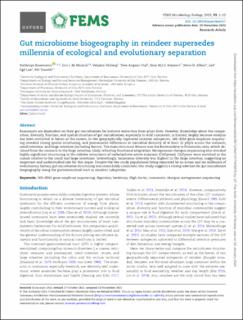Gut microbiome biogeography in reindeer supersedes millennia of ecological and evolutionary separation
Kamenova, Stefaniya; de Muinck, Eric; Veiberg, Vebjørn; Utsi, Tove Hilde Ågnes; Steyaert, Sam; Albon, Steve; Loe, Leif Egil; Trosvik, Pål
Peer reviewed, Journal article
Published version

Åpne
Permanent lenke
https://hdl.handle.net/11250/3109535Utgivelsesdato
2023Metadata
Vis full innførselSamlinger
- Publikasjoner fra CRIStin - NINA [2364]
- Scientific publications [1392]
Sammendrag
Ruminants are dependent on their gut microbiomes for nutrient extraction from plant diets. However, knowledge about the composition, diversity, function, and spatial structure of gut microbiomes, especially in wild ruminants, is limited, largely because analysis has been restricted to faeces or the rumen. In two geographically separated reindeer subspecies, 16S rRNA gene amplicon sequencing revealed strong spatial structuring, and pronounced differences in microbial diversity of at least 33 phyla across the stomach, small intestine, and large intestine (including faeces). The main structural feature was the Bacteroidota to Firmicutes ratio, which declined from the stomach to the large intestine, likely reflecting functional adaptation. Metagenome shotgun sequencing also revealed highly significant structuring in the relative occurrence of carbohydrate-active enzymes (CAZymes). CAZymes were enriched in the
rumen relative to the small and large intestines. Interestingly, taxonomic diversity was highest in the large intestine, suggesting an important and understudied role for this organ. Despite the two study populations being separated by an ocean and six millennia of evolutionary history, gut microbiome structuring was remarkably consistent. Our study suggests a strong selection for gut microbiome biogeography along the gastrointestinal tract in reindeer subspecies.
16S rRNA gene amplicon sequencing; digestion; herbivory; High Arctic; ruminants; shotgun metagenome sequencing
